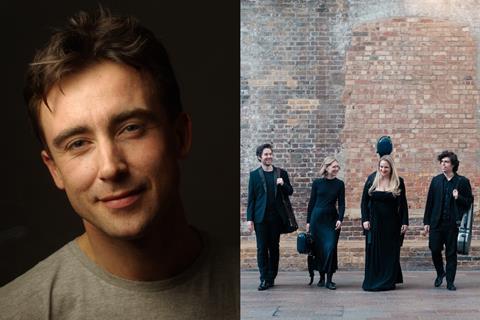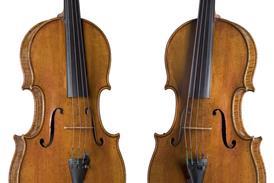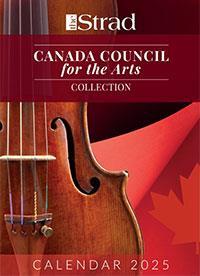The composer shares the inspiration behind his string quartets nos. 2-4, ahead of the recording release by the Piatti Quartet on 1 November

Discover more Featured Stories like this in The Strad Playing Hub
The Piatti Quartet has recorded the second, third and fourth string quartets by UK composer Joseph Phibbs, in a new record set for release on 1 November 2024. The new album coincides with Phibbs’ 50th birthday this year, and marks ten years of collaboration between the ensemble and composer, which began with the commissioning of String Quartet No. 1 by the Piattis in 2014.
Phibbs studied the cello as a child and credits this, his introduction to the music of Britten’s first string quartet at the age of 14, as well as Lutoslawski and his former teacher Steven Stucky, to his special affinity with string music. Throughout his career, he has explored writing for strings, namely for the Piatti Quartet: ’He is the contemporary composer we have performed most often,’ says the quartet, which has recently performed Phibbs’ fourth string quartet at London’s Kings Place.
Phibbs shares the ideas behind these three recently recorded string quartets:
This CD, supported by the Richard Thomas Foundation, presents three of my four string quartets, and is a culmination of a decade working with the Piatti Quartet, among the finest of its generation.
My first quartet was commissioned by the Piattis in 2014, and marked the start of one the most rewarding musical relationships of my career so far. It’s a work they have performed many times, and it was this enthusiasm that led me to explore the genre further in Nos. 2 and 3, composed for the Navarra and Belcea Quartets respectively. Now, a decade after No.1, it’s been a privilege to compose for them again.
Unlike the earlier quartets, No. 4 could be seen as a sequence of contrasting character pieces. Although considerably shorter, it is loosely modelled on Britten’s third quartet: five movements, with a still melodic centre and a passacaglia at the end. The propulsive opening movement (’Film sequence’) is inspired by the world of cinema, repeated notes forming the backdrop to a variety of themes whose development might be heard as a type of narrative.
This is followed by Notturno, where a simple motif high in the upper strings is underpinned by cello pizzicati. Cantilena, dedicated to the memory of the theatre director and priest James Roose Evans, forms the melodic core of the work in which a simple tune slowly rises up through the quartet, underpinned by a low repeated note in the cello. An earthy Burlesque precedes the final Passacaglia, which is interrupted by an extended cello solo: a modest homage to the quartet’s cellist Jessie Ann Richardson, whose playing I have admired so much over the years.
No.3, composed in 2018, is the longest of the three works on the disc, and draws together aspects of Nos. 1 and 2. This was the second piece I had the good fortune of writing for the Belcea Quartet, following The Canticle of the Rose (2005), and it is dedicated both to them and the memory of my former teacher Steven Stucky (1949-2016).
The opening Allegro is the most substantial of the five movements. Subtitled ’Illuminations,’ it is an evocation of city lights, with changing patterns of figuration moving rapidly in and out of focus. The second movement, a fast fugue, was inspired by the finale of Beethoven’s Op.59, No.3, and is rounded off with a frenetic folk-inspired canon between the violins. The third movement, Notturno e fantasia, features solos for the cello and first violin, before a type of minuet and trio follows, a recurring melody appearing in a disjointed way over a pizzicato ostinato. The final movement, a slow vocalise, was written as a tribute to the Belcea Quartet’s violist Krzysztof Chorzelski, a close friend for many years.
Commissioned immediately after No.1, the second quartet (2015) proved especially difficult to write. I wanted to approach the genre from a different angle, and in contrast to the earlier work, where duos are placed around five main movements, a simpler and more traditional four-movement design is used.
The first movement, a type of nocturne, opens with hushed, shimmering figuration in the upper strings’ high register, interspersed with expanding pizzicato episodes, while the second is edgy and fragmented, the material passing briskly between the musicians in a type of fugue. An interlude (Chitarra) acts as a third movement, its title relating to the Spanish guitar-like textures which featurehere. The final movement is lyrical and reflective, a Mahlerian melody in the first violin passing through the quartet, before the piece closes in a blaze of light at the top of the instruments’ registers.
Joseph Phibbs’ String Quartets Nos. 2-4 is released on 1 November 2024 on RTF Classical/Nimbus. The Piatti Quartet will perform String Quartet No. 4 at Cheltenham Town Hall on 6 March 2025.
Read: Premiere: Joseph Phibbs on his new string quintet
Read: ‘This Voller violin has a big sound’: Piatti Quartet violinist Michael Trainor on his instrument
Discover more Featured Stories like this in The Strad Playing Hub
The number one source for playing and teaching books, guides, CDs, calendars and back issues of the magazine.
In The Best of Technique you’ll discover the top playing tips of the world’s leading string players and teachers. It’s packed full of exercises for students, plus examples from the standard repertoire to show you how to integrate the technique into your playing.
The Strad’s Masterclass series brings together the finest string players with some of the greatest string works ever written. Always one of our most popular sections, Masterclass has been an invaluable aid to aspiring soloists, chamber musicians and string teachers since the 1990s.
The Canada Council of the Arts’ Musical Instrument Bank is 40 years old in 2025. This year’s calendar celebrates some its treasures, including four instruments by Antonio Stradivari and priceless works by Montagnana, Gagliano, Pressenda and David Tecchler.





































No comments yet